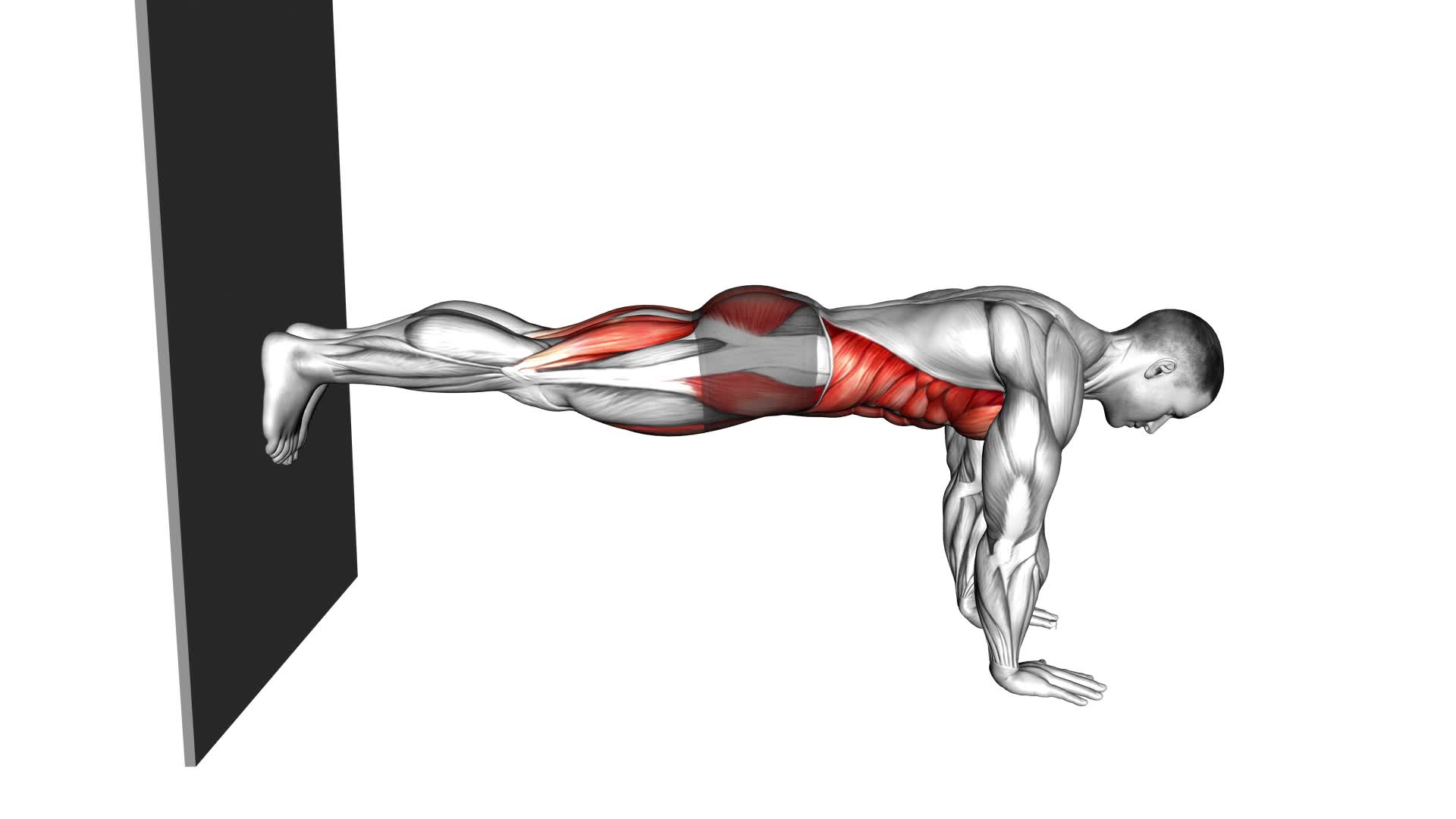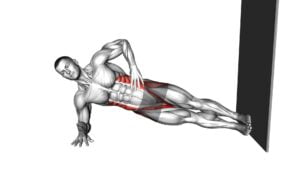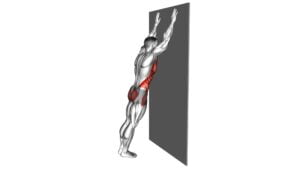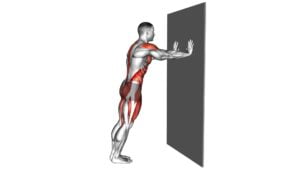Front Plank Against Wall (Male) – Video Exercise Guide & Tips

Get ready to strengthen your core and build a rock-solid foundation with the front plank against the wall. In this video exercise guide, we'll show you the proper form, offer modifications and progressions, and highlight common mistakes to avoid.
Watch This Exercise Video
Maximize the effectiveness of your workout with these expert tips. Whether you're a beginner or advanced, this exercise is a must-try for any male looking to improve strength and stability.
Let's dive in and get those abs firing!
Key Takeaways
- Front plank against the wall strengthens core muscles and improves overall fitness.
- Proper form and technique, such as maintaining a straight line from head to heels and engaging the core, are essential for maximum effectiveness and safety.
- Modifications and progressions, such as lifting one leg or arm off the wall or performing side planks, can increase the challenge and target different muscle groups.
- Consistency and proper rest and recovery are important for seeing improvements in core strength and stability.
Benefits of Front Plank Against Wall
You should regularly practice the front plank against the wall to experience its numerous benefits. This exercise is a great way to strengthen your core and improve your overall fitness. The front plank against the wall is a variation of the traditional front plank, where you rest your forearms on the wall instead of the floor.
One of the main benefits of this variation is that it allows you to focus on engaging your core muscles without putting excessive strain on your wrists or shoulders. By keeping your body in a straight line, you're able to work your abs, back, and glutes effectively. This exercise also helps to improve your posture and stability, as you have to engage your core muscles to maintain the correct position.
Another advantage of the front plank against the wall is that it can be easily modified to suit different fitness levels. You can increase the intensity by holding the position for longer periods of time or by lifting one leg at a time. This variation also allows for progression, as you can gradually increase the difficulty by moving your feet further away from the wall.
Proper Form and Technique
To maintain proper form and technique for the front plank against the wall, it's important to focus on engaging your core muscles and keeping your body in a straight line. Many people have common misconceptions about this exercise, so let's clarify a few things.
First, it's crucial to position your feet against the wall, with your toes pointing up. This creates stability and helps you maintain proper alignment.
Second, avoid sagging or lifting your hips too high. Your body should be parallel to the ground, from your head to your heels.
Lastly, make sure to breathe steadily throughout the exercise, as holding your breath can lead to unnecessary tension.
There are variations and alternatives to the front plank against the wall that you can incorporate into your workout routine. One option is the traditional front plank, where you support your body weight on your forearms and toes, without the wall. This challenges your core muscles even more.
Another alternative is the side plank, where you support your body weight on one forearm and the side of your foot. This targets your obliques and improves stability.
Now that you understand the proper form and technique, let's move on to modifications and progressions to help you advance your front plank against the wall.
Modifications and Progressions
To further challenge yourself and continue progressing with the front plank against the wall, consider incorporating modifications and variations into your routine. These modifications will help you target specific muscle groups and take your plank to the next level.
One way to advance the front plank against the wall is by adding variations to the exercise. You can try lifting one leg off the wall and holding the position for a few seconds before switching to the other leg. This will engage your core muscles even more. Another advanced variation is to lift one arm off the ground and reach it forward while maintaining a strong plank position. This will challenge your stability and work your upper body.
If you want to target specific muscle groups, you can modify the front plank against the wall. For example, to focus on your obliques, you can perform side planks against the wall. Simply position yourself sideways with one forearm resting on the ground and your feet against the wall. Lift your hips off the ground and hold the position.
Remember to always maintain proper form and technique during these advanced variations and modifications. As you continue to progress, you'll strengthen your core and build endurance.
Common Mistakes to Avoid
To ensure that you're performing the front plank against the wall correctly and effectively, it's important to be aware of common mistakes and how to avoid them.
One common mistake isn't maintaining proper form, which can lead to ineffective results and potential injury.
Proper Form Demonstration
Avoid common mistakes during the front plank against the wall exercise by ensuring proper form. To demonstrate proper form, start by positioning yourself facing the wall, with your forearms resting on the ground and your elbows directly below your shoulders. Engage your core muscles and lift your body off the ground, forming a straight line from your head to your heels.
Keep your neck and spine neutral, and avoid arching or rounding your back. Maintain a steady breathing pattern throughout the exercise.
Remember to avoid lifting your hips too high or sagging them too low, as this can put unnecessary strain on your lower back.
Correcting Alignment Errors
To ensure proper alignment and avoid common mistakes, focus on keeping your elbows directly below your shoulders and your forearms resting on the ground when performing the front plank against the wall exercise.
Fixing your posture is crucial for maximizing the benefits and effectiveness of this exercise. Make sure to engage your core muscles by pulling your belly button towards your spine and squeezing your glutes.
This will help maintain a straight line from your head to your heels, preventing your hips from sagging or lifting too high.
It's also important to keep your neck in a neutral position, avoiding any strain or tension.
Tips for Maximizing the Effectiveness
Maximize the effectiveness of your front plank against the wall by focusing on stability and control. To maximize results, it's important to maintain proper form throughout the exercise. Start by positioning yourself in a plank position with your feet against a wall and your forearms on the ground. Engage your core and squeeze your glutes to create a straight line from your head to your heels. Avoid sagging or arching your back, as this can decrease the effectiveness of the exercise.
To increase the challenge, you can try different variations of the front plank against the wall. For beginners, you can start by holding the plank for 10-15 seconds and gradually increase the duration as your strength improves. Intermediate and advanced individuals can try lifting one leg off the ground or placing their feet on an unstable surface, such as a Bosu ball.
Remember to breathe deeply and maintain proper form throughout the exercise. Focus on contracting your abdominal muscles and keeping your body stable.
Sample Front Plank Against Wall Workout
To perform a sample front plank against the wall workout, start by maintaining proper form and stability as discussed in the previous subtopic. Once you have mastered the basic front plank, you can incorporate variations into your routine to target different muscle groups and challenge yourself further.
Here are three front plank variations to try:
- Side Plank with Leg Lift: Begin in a side plank position, with your elbow on the ground and your body in a straight line. Lift your top leg up, keeping it straight, and hold for a few seconds before lowering it back down. This variation targets your obliques and hip abductors.
- Plank with Shoulder Taps: In a standard front plank position, lift one hand off the ground and tap your opposite shoulder. Alternate sides, keeping your core engaged and your body stable. This variation adds an element of balance and coordination to the exercise.
- Plank with Knee Tucks: From a front plank position, bring one knee towards your chest, engaging your abs as you do so. Extend the leg back out and repeat on the other side. This variation targets your hip flexors and adds a dynamic movement to the exercise.
Incorporating front plank variations into a full body workout can help you build core strength, improve stability, and increase overall body awareness. You can include the front plank as part of a circuit or use it as a warm-up exercise before more intense movements. Remember to focus on maintaining proper form and breathing throughout your workout.
Frequently Asked Questions
How Long Should I Hold the Front Plank Against the Wall?
To determine how long you should hold the front plank against the wall, it's important to focus on progression and maintaining proper form.
Start by holding the plank for a short duration, such as 10-20 seconds, and gradually increase the time as you build strength and endurance.
Remember to engage your core, squeeze your glutes, and keep a straight line from your head to your feet.
This will ensure an effective and safe workout.
Can I Do the Front Plank Against the Wall if I Have Lower Back Pain?
If you have lower back pain, it's important to listen to your body and not push yourself too hard.
The front plank against the wall can be a great exercise for core strength, but it may not be suitable for everyone with lower back pain.
It's recommended to consult with a healthcare professional or a certified trainer who can provide modifications to the wall plank exercise that will be more appropriate for your condition.
Is It Necessary to Warm up Before Doing the Front Plank Against the Wall?
Before attempting the front plank against the wall, warming up is highly recommended. Warming up benefits your body by increasing blood flow, loosening muscles, and preparing them for the exercise.
It's crucial to ensure proper form and technique to avoid any potential injuries. To maintain proper form, make sure your body is aligned in a straight line from head to toe, engage your core, and keep your glutes and quads activated.
How Can I Make the Front Plank Against the Wall More Challenging?
To make the front plank against the wall more challenging, you can try advanced variations. Lift one leg off the ground or alternate between lifting each leg.
Another option is to incorporate equipment, such as a stability ball. Place your feet on the ball while in the plank position for added difficulty.
Remember to maintain proper form and engage your core muscles throughout the exercise. Push yourself but listen to your body and don't overdo it.
Are There Any Alternative Exercises to the Front Plank Against the Wall That Target Similar Muscle Groups?
If you're looking for alternative exercises that target similar muscle groups as the front plank against the wall, there are a few options you can try.
One alternative is the traditional forearm plank, which works the core muscles just like the front plank.
Another option is the side plank, which targets the obliques and helps improve stability.
Both of these exercises offer similar benefits to the front plank against the wall and can help you continue challenging your muscles.
Conclusion
In conclusion, the front plank against the wall is an effective exercise for strengthening the core muscles. By maintaining proper form and technique, you can maximize the effectiveness of this exercise.
Modifications and progressions can be made to suit different fitness levels. It's important to avoid common mistakes such as arching the back or holding the position for too long.
Incorporating the front plank against the wall into your workout routine can help improve overall stability and posture.

Author
Years ago, the spark of my life’s passion ignited in my mind the moment I stepped into the local gym for the first time. The inaugural bead of perspiration, the initial endeavor, the very first surge of endorphins, and a sense of pride that washed over me post-workout marked the beginning of my deep-seated interest in strength sports, fitness, and sports nutrition. This very curiosity blossomed rapidly into a profound fascination, propelling me to earn a Master’s degree in Physical Education from the Academy of Physical Education in Krakow, followed by a Sports Manager diploma from the Jagiellonian University. My journey of growth led me to gain more specialized qualifications, such as being a certified personal trainer with a focus on sports dietetics, a lifeguard, and an instructor for wellness and corrective gymnastics. Theoretical knowledge paired seamlessly with practical experience, reinforcing my belief that the transformation of individuals under my guidance was also a reflection of my personal growth. This belief holds true even today. Each day, I strive to push the boundaries and explore new realms. These realms gently elevate me to greater heights. The unique combination of passion for my field and the continuous quest for growth fuels my drive to break new ground.







